Disability leave policy - NASUWT
Disability leave policy - NASUWT
Disability leave policy - NASUWT
Create successful ePaper yourself
Turn your PDF publications into a flip-book with our unique Google optimized e-Paper software.
ModelPolicy<strong>Disability</strong> Leavematters
IntroductionDecades after the enactment of the 1995 <strong>Disability</strong> Discrimination Act and years after the Equality Act 2010 came intolaw, ignorance of the law pertaining to disabled people at work remains widespread and too many employers still do nothave effective policies relating to disability.<strong>Disability</strong> is defined in law as a physical or mental impairment that is long-term and has a substantial adverse impact onsomeone’s ability to carry out normal daily activities.The definition includes people with hidden disabilities (such as epilepsy, mental health issues and diabetes), and includesprogressive and recurring conditions and past disabilities. People with cancer, HIV and Multiple Sclerosis are automaticallycovered by the Act.The definition is a broad one, potentially covering many millions of people. It is important to note that many of thoseprotected by the Equality Act are not aware that they are, and would not necessarily consider themselves to be disabled.Many people still perceive that disability carries a stigma. The experiences of <strong>NASUWT</strong> members suggest that employersneed to be better equipped to manage disabled workers by taking due and proper account of the person’s disability.Adopting a disability <strong>leave</strong> <strong>policy</strong> is a proportionate and appropriate method of addressing misconceptions about disability.It helps to establish an inclusive, accessible and diverse workplace. It also equips employers to meet their statutoryresponsibilities under the 2010 Equality Act. The <strong>NASUWT</strong> has provided this model <strong>policy</strong> to support employers to secureinclusive workplaces that enable disabled teachers to contribute effectively to providing high-quality teaching and learningopportunities for their pupils.3
ContentsModel PolicyPreamble .......................................................................................................................................................... 5<strong>Disability</strong> <strong>leave</strong>............................................................................................................................................... 5Sickness and disability................................................................................................................................. 6Confidentiality................................................................................................................................................ 6Time off to attend medical appointments ........................................................................................... 6Procedure for applying for <strong>leave</strong>.............................................................................................................. 6Review............................................................................................................................................................... 6Other rights and entitlements .................................................................................................................. 6Explanatory GuidancePreamble .......................................................................................................................................................... 7<strong>Disability</strong> <strong>leave</strong>............................................................................................................................................... 7Sickness and disability................................................................................................................................. 8Confidentiality................................................................................................................................................ 8Time off to attend medical appointments ........................................................................................... 8Procedure for applying for <strong>leave</strong>.............................................................................................................. 8Review............................................................................................................................................................... 8Other rights and entitlements .................................................................................................................. 8Appendix OneModel application letter to employer requesting disability <strong>leave</strong>................................................ 94
MODEL POLICY1. Preamble1.1 _______________________________ school/college is committed to creating a positive working environment.Employees with a disability or impairment have the right to be treated with consideration and respect and toreasonable time off for issues related to their disability or impairment.1.2 From time to time, employees may be unable to attend work, need to attend hospital or GP appointments orotherwise be absent, as a result of their disability or impairment. This <strong>policy</strong> sets out the procedures which apply inthese circumstances. Employees are expected to co-operate in ensuring absences related to disability are managedin line with this <strong>policy</strong>.1.3 The school/college will make every effort to ensure the school meets its duties and responsibilities under the EqualityAct 2010. They will support disabled staff and recognise them as valued members of the school workforce. The needsof disabled employees will be balanced with the needs of the school and the pupils.1.4 The school/college acknowledges that it has a responsibility to promote an inclusive and supportive workingenvironment, recognising that a diverse workforce which reflects all sections of the community will include disabledemployees.1.5 This <strong>policy</strong> helps to ensure that disabled employees are not put at a substantial disadvantage in comparison withemployees who are not disabled. The <strong>policy</strong> applies to all employees.1.6 This <strong>policy</strong> is intended to both support staff and enable managers to manage disability-related absences in a waywhich is fair, consistent and complies with employment, equality and health and safety legislation, and that suchabsences are managed effectively and equitably.1.7 The <strong>policy</strong> balances the need to deliver the best possible education service and the interests of employees.1.8. The success of this <strong>policy</strong> is dependant on openness, mutual trust and respect between employees, employeerepresentatives and line managers. It relies on the willingness of all parties to co-operate.1.9 The school/college will actively and positively communicate this <strong>policy</strong> to all staff and train staff and managers asappropriate.1.10 All the school’s policies and procedures will be applied in accordance with the law, including that specifically relatingto disability. The school recognises its duties as a public body to pay ’due regard‘ to the promotion of equality fordisabled people in every area of work. The school’s Equal Opportunities Policy will also reflect the wider requirementsof the legislation.2. <strong>Disability</strong> <strong>leave</strong>2.1. <strong>Disability</strong> <strong>leave</strong> under this <strong>policy</strong> is defined as paid time off for a reason related to an employee’s disability. It can beshort or long periods of time, a single day or a series of days. The length of time off will be decided in the context ofthe test of ‘reasonableness’ dependent upon the individual’s circumstances.2.2 Access to disability <strong>leave</strong> will not be used as a negative criterion for assessing performance, competence, selection forpromotion, professional development, redundancy, or sickness absence monitoring. This list is not exhaustive.2.3. The reasons for an employee’s application for disability <strong>leave</strong> may include one or more of the following:n hospital treatment as in- or out- patient;n counselling or therapeutic treatment;n assessment for diabetes;n recovery after transfusion, dialysis, chemotherapy orn dyspraxia – related treatment;radiotherapy;n HIV – related treatment;n physiotherapy;n training with a guide dog;n to allow adaptions or reasonable adjustments to ben training in use of specialist equipment;made; andn training on Braille, BSL, lip reading;n surgical treatment. This list is not exhaustive.5
3. Sickness and disability3.1 Sickness absence may be related to an employee’s disability and specialist advice will be obtained from OccupationalHealth when necessary.3.2 Self-declaration by the employee or GP/Consultant notes confirming disability or registration as a disabled person willtrigger an automatic assessment of the need for reasonable adjustments to the individual’s working needs orenvironment as may be appropriate.3.3 The school acknowledges that disability is not synonymous either with sickness or absence from work.4. Confidentiality4.1 Information about sickness absence and disability will be handled carefully to ensure that sensitive details remainconfidential in accordance with the provisions of the Access to Medical Reports Act 1988 and the Data Protection Act1998.4.2 Employees are not obliged to inform the employer if they have a disability, but are encouraged to do so, as this allowsfor access to reasonable adjustments and adaptations where necessary.5. Time off to attend medical appointments5.1 Employees will be permitted paid time off to attend medical appointments which relate to the employee’s disabilityand will not unreasonably be refused any request for time off. This will include appointments with their doctor, dentist,optician and any other appointment of a medical nature related to their disability.6. Procedure for applying for <strong>leave</strong>6.1 Employees who wish to apply for disability <strong>leave</strong> should complete the application form provided for this purpose(Appendix 1).6.2 Within five working days of receiving an application for disability <strong>leave</strong>, the request will be considered by their linemanager and the employee will be informed of the outcome.6.4 If the request is declined, the manager will set out in writing the reasons for the decision and arrange to meet withthe employee within ten working days.7. Review7.1 The <strong>policy</strong> will be reviewed every year in consultation with the recognised trade unions.8. Other rights and entitlements8.1 The provisions of this <strong>policy</strong> do not remove the rights of employees in law or under other school policies, including thegrievance procedure.This <strong>policy</strong> was adopted at a meeting of the governing body on [ date ]The <strong>policy</strong> will be reviewed on [ date ]6
EXPLANATORY GUIDANCEThis guidance follows the model <strong>policy</strong> and provides a commentary on the key issues to be considered when seeking toagree the <strong>policy</strong>.PreambleThe ‘Preamble’ identifies the need to comply with the regulatory framework and the need for managers to manage sicknessabsence in a fair and consistent manner. It sets out the scope and intention of the <strong>policy</strong> and confirms that the recognisedtrade unions were consulted as part of its development.It sets out the commitment of the employer and highlights that all parties have a responsibility to comply with the <strong>policy</strong>.The relevant legislation underpinning disability <strong>leave</strong> includes the following:n Health and Safety at Work Act 1974 (c. 37)n Access to Medical Reports Act 1988n Data Protection Act 1988n Management of Health and Safety at Work Regulations 1999 (no 3242)n Employment Rights Act 1996 (c.18)n Data Protection Act 1998n Social Security (Medical Evidence) and Statutory Sick Pay (Medical Evidence) (Amendment) Regulations 2010(no 137)n Equality Act 2010 (c.15)n Equality Act 2010 (Specific Duties) Regulations 2011 (c. 2)The Equality Act 2010 superseded the <strong>Disability</strong> Discrimination Acts (DDA) 1995 and 2005. The Equality Act imposes aduty not to discriminate on the grounds of nine protected characteristics, including disability. The types of conduct madeunlawful or prohibited by the Act are: direct discrimination; indirect discrimination; harassment; victimisation; failure to makereasonable adjustments; discrimination arising from disability; and discrimination based on association and perception.An example of indirect discrimination in this respect would be where the school applies a practice or criterion that woulddisproportionately impact on employees with a disability. For example, establishing a pay <strong>policy</strong> that adversely impacts onemployees taking long-term sick <strong>leave</strong> may indirectly discriminate against disabled employees who potentially are morelikely to take lengthy sick <strong>leave</strong> as a result of their impairment.In addition, there are provisions allowing positive action by public sector organisations to take proportionate steps to helpdisabled people overcome disadvantage.Equality law allows an employer to treat a disabled employee more favourably than a non-disabled person if it is recognisedthat the disabled employee would be at a disadvantage. For example, it would be lawful for an employer to introducespecific training for a disabled employee as a form of reasonable adjustment.<strong>Disability</strong> <strong>leave</strong>This section defines disability <strong>leave</strong> and is compatible with good practice on complying with statutory provisions andensuring that employers do not become vulnerable to claims of unlawful discrimination.It distinguishes between sickness and disability and highlights that using disability-related absences as a negative factor inassessing entitlement to salary, pay progression, promotion or other elements of conditions of service, such as performancemanagement/appraisal, is potentially discriminatory. Reasonableness is not defined in law. It is left to individuals andshould take account of the balance of an individual’s needs against that of the service.7
Sickness and disabilityThe Equality Act 2010 defines a person with a disability as a person with a physical or mental impairment, which has asubstantial and long-term adverse effect on their ability to carry out normal day-to-day activities. Under the Equality Act2010, employers have a duty to make ‘reasonable adjustments’ where any aspect of working arrangements (includingpremises) places a person with a disability at a substantial disadvantage.ConfidentialityInformation about an individual’s disability or impairment should be handled in a sensitive and confidential manner by allparties. The Data Protection Act 1998 and the Access to Medical Reports Act 1988 provide protections to individuals inthis respect. All sensitive and confidential information on an employee should be stored in a safe and secure environment.The disclosure of confidential information in the employment context is also protected by the implied duty of trust andconfidence owed by an employer to an employee.Although an employer need not know of an employee’s disability in order to subject the person to discrimination, a‘knowledge’ of disability is an essential requirement for reasonable adjustments to apply.Time off to attend medical appointmentsSome employers may wish to insert an amendment to the effect that employees should try to ensure that non-urgentmedical appointments or appointments not relating to their disability take place in their own time. Such an amendmentwould be acceptable, but only where there is an agreement to add to the <strong>policy</strong> that this may not be possible in allcircumstances – for example, hospital appointments and treatments.Medical appointments may already be covered in a separate <strong>leave</strong> <strong>policy</strong>, particularly if it is a medical emergency, or as anauthorised absence with or without pay. This <strong>policy</strong> should be consistent with the <strong>leave</strong> <strong>policy</strong> and that <strong>policy</strong> may need tobe amended if it fails to comply with good practice. This section refers to absences related to or caused by the person’sdisability. The employee should, where possible, produce evidence of appointments to the employer.Procedure for applying for <strong>leave</strong>The procedure for applying for disability <strong>leave</strong> should be transparent and contain timescales appropriate for ensuringdecisions on applications are made in a timely manner.The application form should include: the applicant’s name; location; reason for the request; dates or time required; whoconducts the review and appeal; and the line manager’s agreement or, in the case of refusal, the reason given for refusal.Applicants should keep a copy of the form they submit and the information they provide.When applying for disability <strong>leave</strong>, the employee should provide as much information as possible to support theirapplication and to enable an informed decision to be made.ReviewIt is important that policies are regularly reviewed, in consultation with trade unions, to ensure that they are fit for purposeand up to date.Other rights and entitlementsThis is an important section to make clear that employees’ rights under other school policies or in law are not prejudiced byany provisions set out in this <strong>policy</strong>.Any employee who feels aggrieved at the way in which their request for disability <strong>leave</strong> or absence on disability <strong>leave</strong> hasbeen dealt with may invoke the school (or other relevant) grievance procedure if they believe the <strong>policy</strong> has not beenfollowed correctly.8
Appendix One Model application form for <strong>Disability</strong> LeaveDear ______________Date ______________Name of applicant _____________________________________Under these provisions and in line with the disability <strong>leave</strong> <strong>policy</strong>, I wish to apply for <strong>leave</strong> of absence for________________ day(s) commencing ______________ and ending ________________.The reasons for this absence are (give full details):Attachments (e.g. medical appointment letter)I have attached the following information:Signed [ applicant ]To be completed by the line managerI confirm that the <strong>leave</strong> requested has been granted.Signed: ___________________________________Date: ________________Your request has been declined.Signed: ___________________________________Date: ________________Reasons for not granting the <strong>leave</strong>:Date to meet with employee to discuss decision: ________________9
<strong>NASUWT</strong>The Teachers’ UnionHillscourt Education Centre, Rose Hill,Rednal, Birmingham B45 8RSTel: 0121 453 6150 Fax: 0121 453 6208E-mail: nasuwt@mail.nasuwt.org.ukWebsite: www.nasuwt.org.uk13/06017 England The largest teachers’ union in the UK


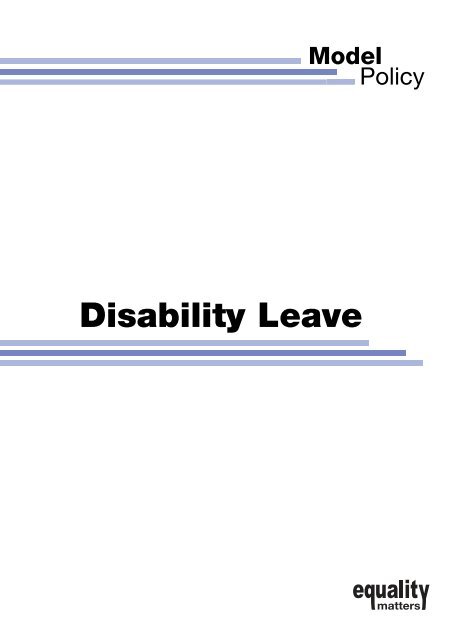


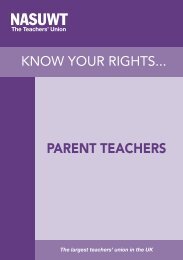
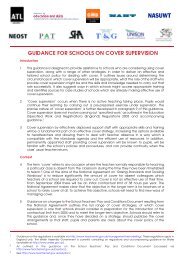
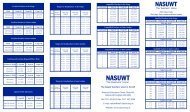
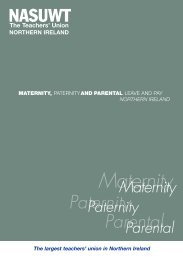
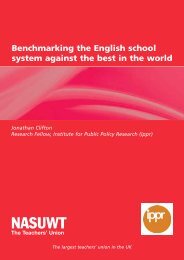
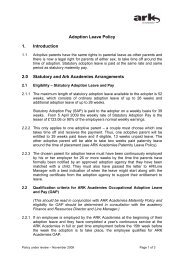


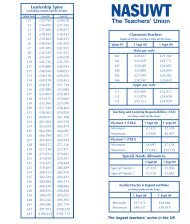

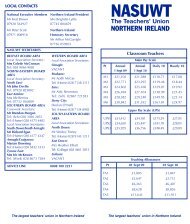
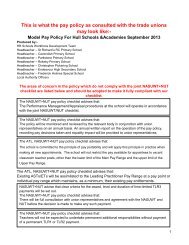
![Salaries (London & Fringe) 2012-2013 [pdf - 281 kb] - NASUWT](https://img.yumpu.com/47816007/1/190x112/salaries-london-fringe-2012-2013-pdf-281-kb-nasuwt.jpg?quality=85)